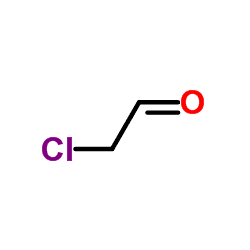Appearance Colourless liquid Molar mass 78.5 g/mol | Formula C2H3Cl | |
 | ||
Related compounds | ||
Chloroacetaldehyde is the organic compound with the formula ClCH2CHO. Like some related compounds, it is highly electrophilic reagent and a potentially dangerous alkylating agent. The compound is not normally encountered in the anhydrous form, but rather as the hydrate (acetal), ClCH2CH(OH)2. Chloroacetaldehyde is a useful intermediate in the synthesis, e.g. of 2-aminothiazole or many pharmaceutical compounds. Another use is to facilitate bark removal from tree trunks.
Contents

Synthesis and reactions
The hydrate of chloroacetaldehyde is produced by the chlorination of aqueous vinyl chloride:
ClCH=CH2 + Cl2 + H2O → ClCH2CHO + 2 HCl
It can also be prepared from vinyl acetate. The related bromoacetaldehyde is prepared via bromination of vinyl acetate. It also rapidly forms an acetals in the presence of alcohols.

Being bifunctional, chloroacetaldehyde is a versatile precursor to many heterocyclic compounds. It condenses with thiourea derivatives to give aminothiazoles. This reaction was once important as a precursor to sulfathiazole, one of the first sulfa drugs.
Environmental aspects

Chloroacetaldehyde is a metabolite in the degradation of 1,2-dichloroethane, which initially converts to chloroethanol. This metabolic pathway is topical since billions of kilograms of 1,2-dichloroethane have been produced as a precursor to vinyl chloride.
Safety
Based on data collected from human studies in 1962, exposures to 45 ppm of chloroacetaldehyde were found to be very disagreeable and caused conjunctival irritation to the subjects. The Occupational Safety and Health Administration established a permissible exposure limit at a ceiling of 1 ppm (3 mg/m3) for exposures to chloroacetaldehyde.
